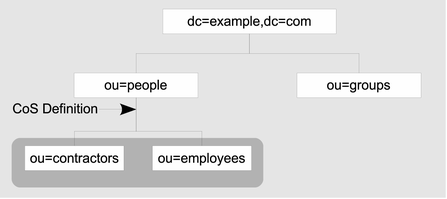| Skip Navigation Links | |
| Exit Print View | |

|
Oracle Directory Server Enterprise Edition Reference 11 g Release 1 (11.1.1.5.0) |
| Skip Navigation Links | |
| Exit Print View | |

|
Oracle Directory Server Enterprise Edition Reference 11 g Release 1 (11.1.1.5.0) |
1. Directory Server Enterprise Edition File Reference
Software Layout for Directory Server Enterprise Edition
Directory Server Instance Default Layout
Directory Proxy Server Instance Default Layout
Part I Directory Server Reference
4. Directory Server LDIF and Search Filters
6. Directory Server Monitoring
7. Directory Server Replication
8. Directory Server Data Caching
11. Directory Server Groups and Roles
12. Directory Server Class of Service
Pointer CoS, Indirect CoS, and Classic CoS
Managing Attributes With Class of Service
Using CoS When Many Entries Share the Same Value
Using CoS When Entries Have Natural Relationships
Avoiding Excessive CoS Definitions
14. Directory Server Internationalization Support
Part II Directory Proxy Server Reference
15. Directory Proxy Server Overview
16. Directory Proxy Server Load Balancing and Client Affinity
17. Directory Proxy Server Distribution
18. Directory Proxy Server Virtualization
19. Connections Between Directory Proxy Server and Backend LDAP Servers
20. Connections Between Clients and Directory Proxy Server
21. Directory Proxy Server Client Authentication
22. Security in Directory Proxy Server
23. Directory Proxy Server Logging
The CoS mechanism relies on two types of entries, the CoS definition entry and the CoS template entry. This section describes the CoS definition entry and the CoS template entry.
The CoS definition entry identifies the type of CoS and the names of the CoS attributes that will be generated. Like the role definition entry, the CoS definition entry inherits from the LDAPsubentry object class. Multiple definitions may exist for the same CoS attribute, which, as a result, may be multivalued.
The CoS definition entry is an instance of the cosSuperDefinition object class. The CoS definition entry also inherits from one of the following object classes to specify the type of CoS:
cosPointerDefinition
cosIndirectDefinition
cosClassicDefinition
The CoS definition entry contains the attributes specific to each type of CoS for naming the virtual CoS attribute, the template DN, and the specifier attribute in target entries. By default, the CoS mechanism will not override the value of an existing attribute with the same name as the CoS attribute. However, the syntax of the CoS definition entry allows you to control this behavior.
When schema checking is turned on, the CoS attribute will be generated on all target entries that allow that attribute. When schema checking is turned off, the CoS attribute will be generated on all target entries.
The location of the definition entry determines the scope of the CoS, which is the entire subtree below the parent of the CoS definition entry. All entries in the branch of the definition entry’s parent are called target entries for the CoS definition.
The following figure shows a CoS definition entry at the root of the ou=people subtree. The scope of the CoS is only the two subtrees beneath the root. The CoS does not extend above this root, or to other subtrees in the DIT.
Figure 12-1 CoS Scope

The CoS template entry contains the value that is generated for the CoS attribute. All entries within the scope of the CoS use the values defined here. There may be several templates, each with a different value, in which case the generated attribute may be multivalued. The CoS mechanism selects one of these values based on the contents of both the definition entry and the target entry.
The CoS template entry is an instance of the cosTemplate object class. The CoS template entry contains the value or values of the attributes generated by the CoS mechanism. The template entries for a given CoS are stored in the directory tree at the same level as the CoS definition.
When possible, definition and template entries should be located in the same place, for easier management. You should also name them in a way that suggests the functionality they provide. For example, a definition entry DN such as "cn=classicCosGenEmployeeType,ou=People,dc=example,dc=com" is more descriptive than "cn=ClassicCos1,ou=People,dc=example,dc=com". For more information about the object classes and attributes associated with each type of CoS, see Class of Service in Oracle Directory Server Enterprise Edition Administration Guide.